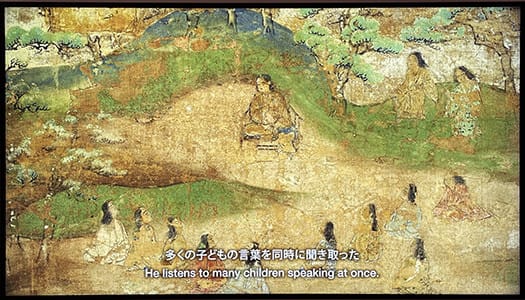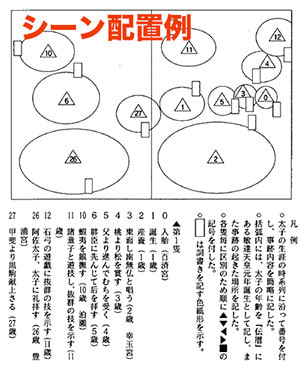


さて、聖徳太子絵伝の中身・内容に分け入ってみよう。
写真のこのシーンが有名な「同時に10人の話をそれぞれに明瞭に聞き分け、理解していた」という常人を超えた太子の天才能力の発露とされる説話。子ども同士の会話であり内容自体はたわいのない日常的話題だっただろうから大略の内容は把握していたことはわかるけれど、しかし10人というのはやはり驚く。現代では「聞く力」をキャッチに使う人物もいるが(笑)。
そしてこういう説話を壁画全体の中でいちばん最初の隻に配置させたことで、聖徳太子の事跡全体にインパクトを一気通貫させる意味合いが込められたのだろう。後世の人間としては、太子没後400年近くになった平安時代の人びとにこのようにアナウンスして、それが以後の民族史全体に情報拡散されて一定の信用性を持っていた事実が面白い。


上の写真は全体として5隻10幅(5せき10ぷく。壁面絵画として3面の壁面に各部が配置されている)である壁面画のうちの第1隻。このなかで矢印の位置に、聖徳太子11歳のときの事跡として子どもたちと車座になって談笑している様子が描かれている。
この日本社会に登場した「絵伝」というものが果たした役割として、始原的な「情報メディア」であったことがよくわかる。絵伝という情報伝達形式は四天王寺などがこの時代までに活用していたという。仏教というものが日本社会に深く根付いていった過程で、このような伝達ツールについても独自開発・進化していったものと考えられる。
はじめは中国仏教の絵画形式が日本社会に導入されたといわれるけれど、やがて日本独自の「やまと絵」スタイルが確立してこのような形式に至っていたとのこと。そのように見てみると、この全体的な「迷宮のような事跡ニュース配置形式」は、現代の新聞などのメディアの「記事配置」と照合しているというようにもとらえることができるかと。
識字普及率が江戸期のようには高くないことがあきらかな平安時代、こういったメディアスタイルの採用には蓋然性が高いと思う。先日、迷宮のようなユニークな形式と絵伝について評した米識者の意見を書いたけれど、現代の新聞メディアでもそれぞれの情報について印象操作するために紙面に大きくバランス付けをしている。よく似ているのではないだろうか。雑誌人としては意図がよくわかる。
じっくり見てくるとここのように情報メディアである意味合いがつよく感じられてくる。日本で鎮護国家思想が貫徹され成功裡に仏教が国民に根付いていった過程には、こういう情報伝達についての進化発展が大きく与っていたと言えるのだろうと思う。
もちろん印刷拡散という段階ではなく法隆寺の一建築内でのコーナー展示であり、それもたぶん一般民衆よりも支配階級向けのものであったとはいえ、太子の少年らしい表情の表現は深い好感をひとびとに、体験型のメディアとして時間を掛けて情報拡散されていったのではないか。
English version⬇
Shotoku Taishi: Understanding Ten People's Stories at the Same Time? The Gallery of Horyuji Treasures-4
I was tempted to say, "Really?" (laugh), but the expression on the cute boy's face was so deeply favorable that it permeated the history of the people. ...
Now, let's take a look at the contents of the Shotoku Taishi Pictorial Biography.
This scene in the photo is the famous story of Prince Shotoku's genius, which is said to have been manifested in his ability to hear and understand 10 people's conversations at the same time, which is beyond ordinary people. The conversation was between children, and the content itself was probably a trivial everyday topic, so it is clear that he had a general grasp of the content, but 10 people is still astonishing. In modern times, some people use the "power of listening" as a catchphrase (laugh).
The placement of these stories on the first ship in the entire mural painting is probably meant to convey the impact of the whole of Prince Shotoku's life. As a person of later generations, it is interesting to know that this kind of announcement to the people of the Heian period, nearly 400 years after the death of Prince Shotoku, was spread throughout the entire history of the people and had a certain degree of credibility.
The photo above shows the first of the five vessels (5 seki-10puku, each section of which is arranged on three walls as a wall painting). The photo above shows the first of the five vessels and ten panels (5 seki 10 puku, each section of which is arranged on three walls as a wall painting). In this painting, the arrow indicates that Prince Shotoku was 11 years old when he was sitting in a circle with his children and chatting with them.
The role played by the pictorial tradition in Japanese society can be clearly seen as a primitive form of "media. The pictorial tradition was utilized by Shitennoji Temple and others by this time. As Buddhism became deeply rooted in Japanese society, it is thought that such a communication tool was developed and evolved in its own way.
It is said that Chinese Buddhist painting styles were first introduced into Japanese society, but eventually a uniquely Japanese "Yamato-e" style was established, leading to this form of painting. In this way, the overall "labyrinthine news layout" can be seen as a reference to the "article layout" of modern newspapers and other media.
In the Heian period, when it was clear that the literacy rate was not as high as in the Edo period, it is highly probable that this kind of media style was adopted. The other day, I wrote about the opinion of an American expert who described the unique labyrinth-like format of the pictorial traditions, but even today's newspaper media heavily balance their pages to manipulate the impression of each piece of information.
If you take a closer look at it, you will realize that it is a media of information. I think it is fair to say that the development of this type of information transmission contributed greatly to the process by which the idea of the state as a guardian nation was carried through in Japan and Buddhism successfully took root among the Japanese people.
Of course, the exhibition was not at the stage of being printed and disseminated, but rather it was a corner exhibition within a building of Horyuji Temple, and although it was probably intended for the ruling class rather than the general public, the boyish expressions on the Taishi's face were deeply appreciated by people, and the information was disseminated over time as an experiential medium.



















